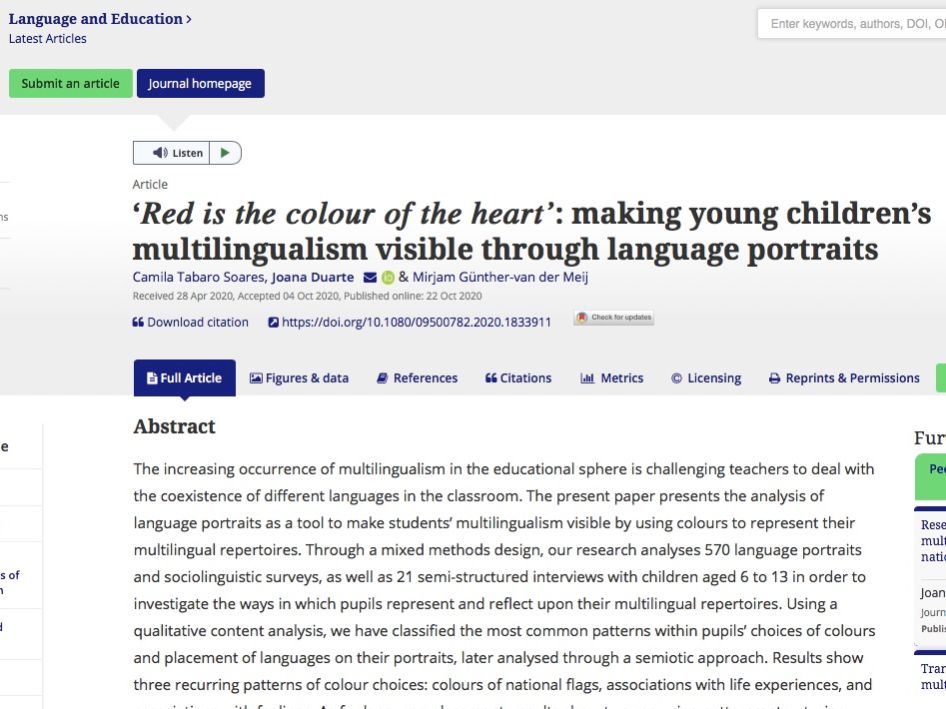Open Access Publication in the Spotlight (January) - 'Red is the Colour of the Heart'
| Date: | 27 January 2021 |
| Author: | Open Access Team |

Each month, the open access team of the University of Groningen Library (UB) puts a recent open access article by UG authors in the spotlight. This publication is highlighted via social media and the library’s newsletter and website.
The article in the spotlight for the month of January 2021 is titled ‘Red is the colour of the heart’: making young children’s multilingualism visible through language portraits, written by Camila Tabaro Soares, Joana Duarte (both from the Multilingualism & Minorities programme at the Faculty of Arts) and Mirjam Günther-van der Meij (NHL Stenden University of Applied Sciences).
Abstract
The increasing occurrence of multilingualism in the educational sphere is challenging teachers to deal with the coexistence of different languages in the classroom. The present paper presents the analysis of language portraits as a tool to make students’ multilingualism visible by using colours to represent their multilingual repertoires. Through a mixed methods design, our research analyses 570 language portraits and sociolinguistic surveys, as well as 21 semi-structured interviews with children aged 6 to 13 in order to investigate the ways in which pupils represent and reflect upon their multilingual repertoires. Using a qualitative content analysis, we have classified the most common patterns within pupils’ choices of colours and placement of languages on their portraits, later analysed through a semiotic approach. Results show three recurring patterns of colour choices: colours of national flags, associations with life experiences, and associations with feelings. As for language placement, results show two recurring patterns: structuring languages according to linguistic skills, and according to body functions. The analysis also revealed a tendency among participants of representing their languages through a “monolingual lens” (García and Flores) and draws implications for the implementation of multilingual education.
We asked the corresponding author, Joana Duarte, a few questions about the article:
This article was published open access, was open access a deliberate choice?
Yes. We chose a journal with an open access option so that we could quickly share our research with the schools that participated in the project that we report on.
The article was published under the terms of the CC-BY-NC-ND (Creative Commons Attribution-NonCommercial-NoDerivatives) license. Why did you choose this license?
We wished our research to be shared and copied by other researchers and students without any restrictions. This guarantees dissemination of knowledge but also facilitates quotations by other researchers*.
Do you find, as a researcher working at the Faculty of Arts, that it is hard for you to publish your work open access – harder maybe than for researchers working in STM (Science, Technology, Medicine)?
I have no experience with publishing in STM. But I do not find it difficult to publish open access in the humanities, especially in the last years. In the humanities articles are also gradually being considered “more important” than book chapters, so most journals have open access options (that you publish online first with a DOI and only later your article will be printed with page numbers for the “paying customers”).
Could you reflect on your experiences with open access and open science in general?
In general, it is still customary that you publish edited volumes and book chapters in publications that are not open access and articles in open access journals. I find the restrictions around the book chapters - how long you have to wait until you can share something on ResearchGate, for example - not adequate anymore, in times of online work and digital access to so many sources. But I do understand that book publishers need to earn their money, of course. It leads me, however, to increasingly wish to publish articles instead of book chapters, so that I can share my research more quickly (which is often a requirement from a funding agency, for example). I only write book chapters now for largely renowned publishing houses in my research area (e.g. Routledge or Multilingual Matters), which is actually a pity.
* The CC-BY-NC-ND license is actually the most restrictive license. It only allows copying and distributing the material in unadapted form, for noncommercial purposes only. Derivatives or adaptations are not permitted. The CC-BY is the most liberal license, it allows others to distribute, remix, tweak, and build upon a work – also commercially – provided they credit the author for the original creation and clearly indicate that changes were made to the work, if any.
Useful links:
The six types of Creative Commons licenses: https://creativecommons.org/about/cclicenses/
A Guide to Creative Commons for Scholarly Publications and Educational Resources
Citation:
Soares, C. T., Duarte, J., & Günther-van der Meij, M. (2020). “Red is the colour of the heart”: making young children’s multilingualism visible through language portraits. Language and Education, 1–20. doi:10.1080/09500782.2020.1833911
If you would like us to highlight your open access publication here, please get in touch with us.


